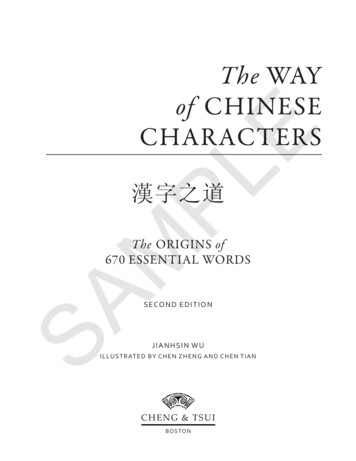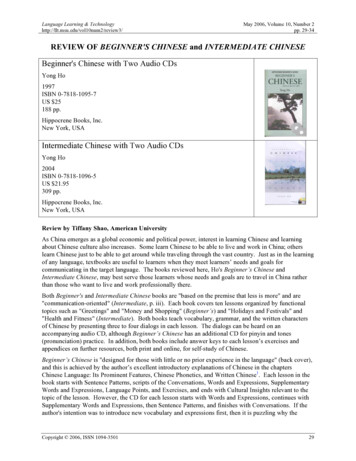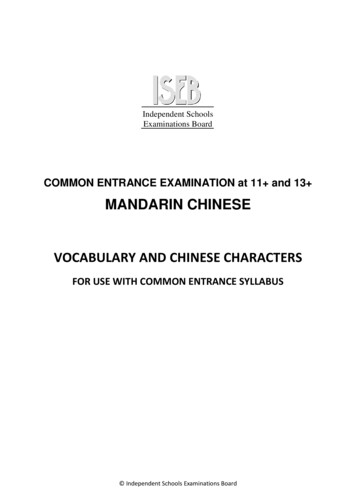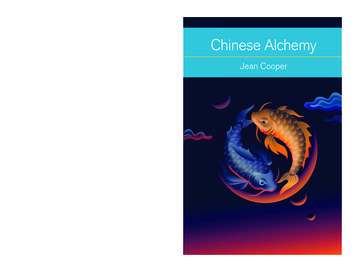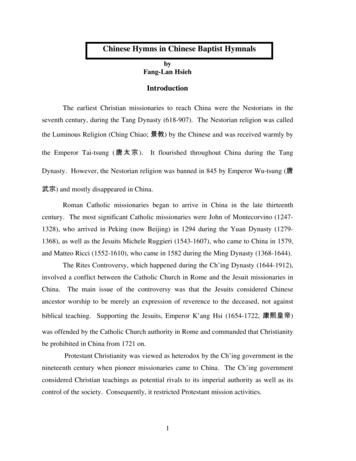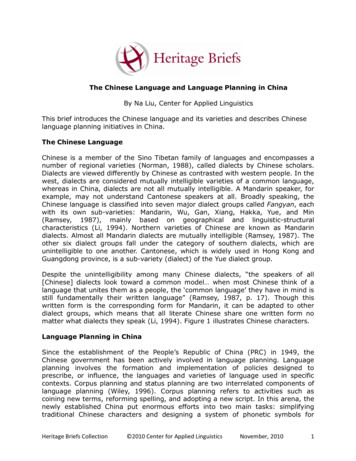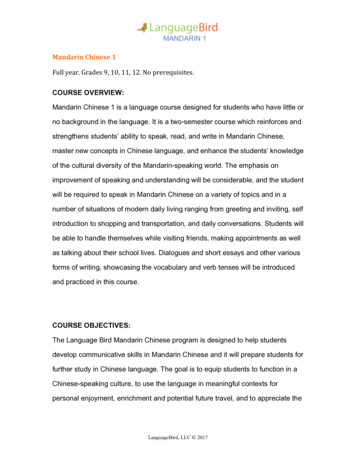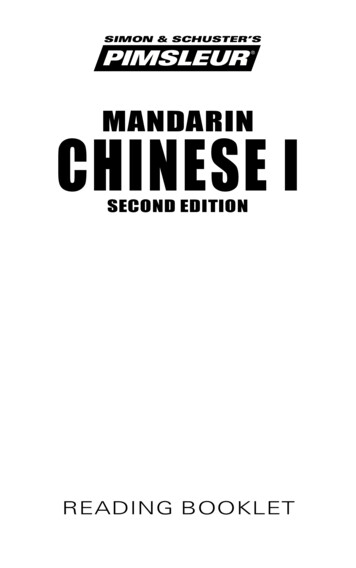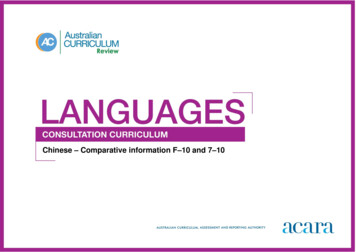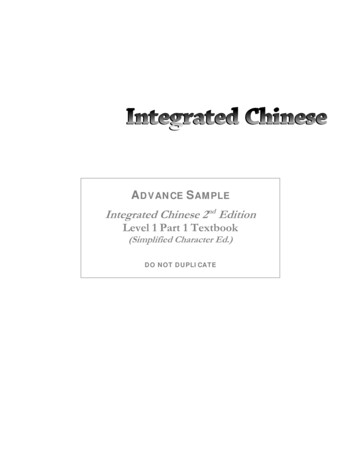
Transcription
Integrated ChineseADVANCE SAMPLEIntegrated Chinese 2nd EditionLevel 1 Part 1 Textbook(Simplified Character Ed.)DO NOT DUPLICATE
CHENG & TSUI PUBLICATIONS OF RELATED INTERESTMaking Connections: Enhance Your Listening Comprehension in Chinese(Text & Audio CD Set)Madeline K. Spring Includeslessons for Integrated Chinese users.Simplified CharactersTraditional Characters0-88727-366-10-88727-365-3Chinese BuilderCards: The Lightning Path to Mastering VocabularySong Jiang and Haidan Wang Includesvocabulary from Integrated Chinese.Simplified CharactersTraditional Characters0-88727-434-X0-88727-426-9Cheng & Tsui Chinese-Pinyin-English Dictionary for LearnersWang Huan, Editor-in-ChiefPaperback0-88727-316-5Cheng & Tsui Chinese Character DictionaryWang Huidi, Editor-in-ChiefPaperback0-88727-314-9Crossing Paths: Living and Learning in China, An Intermediate ChineseCourseHong Gang Jin and De Bao Xu, with Der-lin Chao, Yea-fen Chen, and Min ChenPaperback & Audio CD Set0-88727-370-XShifting Tides: Culture in Contemporary China, An Intermediate ChineseCourseHong Gang Jin and De Bao Xu, with Songren Cui, Yea-fen Chen, and Yin ZhangPaperback & Audio CD Set0-88727-372-6Please visit www.cheng-tsui.com for more information on these and manyother language-learning resources, or visit www.webtech.cheng-tsui.com forinformation on web-based and downloadable products.
LEVEL 1Part 1Integrated Chinese中文聽說讀寫Simplified Character EditionTEXTBOOK2nd EditionTao-chung Yao and Yuehua LiuLiangyan Ge, Yea-fen Chen, Nyan-ping Bi,Xiaojun Wang and Yaohua Shi
Copyright 2005, 1997 Tao-chung Yao, Yuehua Liu, Liangyan Ge, Yea-fen Chen, Nyan-pingBi, Xiaojun Wang and Yaohua ShiSecond EditionAll rights reserved. No part of this publication may be reproduced or transmitted in anyform or by any means, electronic or mechanical, including photocopying, recording, scanning, or any information storage or retrieval system, without written permission from thepublisher.10 09 08 07 06 0510 9 8 7 6 5 4 3 2 1Published byCheng & Tsui Company, Inc.25 West StreetBoston, MA 02111-1213 USAFax (617) 426-3669www.cheng-tsui.com“Bringing Asia to the World”TMLibrary of Congress Cataloging-in-Publication Data is available for this title.Integrated Chinese Level 1 Part 1 TextbookSimplified Character EditionISBN 0-88727-460-5The Integrated Chinese series includes books, workbooks, character workbooks, audioproducts, multimedia products, teacher’s resources, and more. Visit www.cheng-tsui.comfor more information on the other components of Integrated Chinese.Printed in the United States of America
THE INTEGRATED CHINESE SERIESThe Integrated Chinese series is a two-year course that includes textbooks,workbooks, character workbooks, audio CDs, CD-ROMs, DVDs and teacher’sresources.Textbooks introduce Chinese language and culture through a series of dialogues and narratives, with culture notes, language use and grammar explanations, and exercises.Workbooks follow the format of the textbooks and contain a wide range ofintegrated activities that teach the four language skills of listening, speaking,reading and writing.Character Workbooks help students learn Chinese characters in their correct stroke order. Special emphasis is placed on the radicals that are frequently used to compose Chinese characters.Audio CDs include the narratives, dialogues and vocabulary presented in thetextbooks, as well as pronunciation and listening exercises that correspondto the workbooks.Teacher’s Resources contain helpful guidance and additional activitiesonline.Multimedia CD-ROMs are divided into sections of listening, speaking, reading and writing, and feature a variety of supplemental interactive games andactivities for students to test their skills and get instant feedback.Workbook DVD shows listening comprehension dialogues from the Level 1Part 1 Workbook, presented in contemporary settings in color video format.
PUBLISHER’S NOTEWhen Integrated Chinese was first published in 1997, it set a new standardwith its focus on the development and integration of the four language skills(listening, speaking, reading and writing). Today, to further enrich the learning experience of the many users of Integrated Chinese worldwide, the Cheng& Tsui Company is pleased to offer the revised, updated and expanded secondedition of Integrated Chinese. We would like to thank the many teachers andstudents who, by offering their valuable insights and suggestions, havehelped Integrated Chinese evolve and keep pace with the many positive changes in the field of Chinese language instruction. Integrated Chinese continuesto offer comprehensive language instruction, with many new features.The Cheng & Tsui Asian Language Series is designed to publish and widelydistribute quality language learning materials created by leading instructorsfrom around the world. We welcome readers’ comments and suggestionsconcerning the publications in this series. Please send feedback to our Editorial Department (e-mail: editor@cheng-tsui.com), or contact the followingmembers of our Editorial Board.Professor Shou-hsin Teng, Chief Editor3 Coach Lane, Amherst, MA 01002Professor Dana Scott BourgerieAsian and Near Eastern LanguagesBrigham Young University, Provo, UT 84602Professor Samuel CheungDept. of Chinese, Chinese University of Hong Kong,Shatin, Hong KongProfessor Ying-che LiDept. of East Asian Languages, University of Hawaii,Honolulu, HI 96822Professor Timothy LightDept. of Comparative Religion, Western Michigan University,Kalamazoo, MI 49008
CONTENTSPreface . . . . . . . . . . . . . . . . . .Abbreviations for Grammar TermsAbout Note References . . . . . . .Introduction . . . . . . . . . . . . . .xvxxxxi. 11. Chinese Pronunciation . . . . . . . . . . . . . . . . . . . . . . . . 12. Chinese Writing System . . . . . . . . . . . . . . . . . . . . . . . 203. Useful Expressions . . . . . . . . . . . . . . . . . . . . . . . . . . 26Lesson 1: Greetings29Vocabulary and Texts. . . . . . . . . . . . . . . . . . . . . . . . . . . . 29Dialogue I: Exchanging Greetings . . . . . . . . . . . . . . . . . . . 30Dialogue II: Asking One’s Status . . . . . . . . . . . . . . . . . . . . 33Supplementary Vocabulary . . . . . . . . . . . . . . . . . . . . . . . 35Grammar . . . . . . . . . . . . . . . . . . . . . . . . . . . . . . . . . . . 361. The Verb 姓 (xìng)2. Questions Ending with 呢 (ne)3. The Verb 叫 (jiào)4. The Verb 是 (shì)5. Questions Ending with 嗎 (ma)6. The Negative Adverb 不 (bù)7. The Adverb 也 (yě)Pattern Drills . . . . . . . . . . . . . . . . . . . . . . . . . . . . . . . . . 43Pronunciation Exercises . . . . . . . . . . . . . . . . . . . . . . . . . . 49English Texts . . . . . . . . . . . . . . . . . . . . . . . . . . . . . . . . . 50Lesson 2: Family51Vocabulary and Texts. . . . . . . . . . . . . . . . . . . . . . . . . . . . 51Dialogue I: Looking at a Family Photo . . . . . . . . . . . . . . . . . 51Dialogue II: Asking about Someone’s Family . . . . . . . . . . . . . 55Grammar . . . . . . . . . . . . . . . . . . . . . . . . . . . . . . . . . . . 581. Measure Words (I)2. Interrogative Pronouns
xIntegrated Chinese Level 1 Part 1: Textbook 3. 有 (yǒu) in the Sense of “to Have” or “to Possess”4. 有 (yǒu) in the Sense of “to Exist”5. The Usage of 二 (èr) and 兩 (liǎng)6. 都 (dōu, both; all)Pattern Drills . . . . . . . . . . . . . . . . . . . . . . . . . . . . . . . . . 64Pronunciation Exercises . . . . . . . . . . . . . . . . . . . . . . . . . . 70English Texts . . . . . . . . . . . . . . . . . . . . . . . . . . . . . . . . . 71Lesson 3: Dates and Time72Vocabulary and Texts. . . . . . . . . . . . . . . . . . . . . . . . . . . . 72Dialogue I: Taking Someone Out to Eat on His/Her Birthday. . . . 72Dialogue II: Inviting Someone to Dinner . . . . . . . . . . . . . . . 78Supplementary Vocabulary . . . . . . . . . . . . . . . . . . . . . . . 80Grammar . . . . . . . . . . . . . . . . . . . . . . . . . . . . . . . . . . . 821. Numbers (0, 11–100)2. Dates and Time3. Pronouns as Modifiers and the Usage of 的 (de)4. Pivotal Sentences5. Alternative Questions6. Affirmative Negative (A-not-A) Questions (I)7. 還有 (hái yǒu, also, too, in addition) NounPattern Drills . . . . . . . . . . . . . . . . . . . . . . . . . . . . . . . . . 89Pronunciation Exercises . . . . . . . . . . . . . . . . . . . . . . . . . . 94English Texts . . . . . . . . . . . . . . . . . . . . . . . . . . . . . . . . . 95Lesson 4: Hobbies97Vocabulary and Texts. . . . . . . . . . . . . . . . . . . . . . . . . . . . 97Dialogue I: Talking about Hobbies . . . . . . . . . . . . . . . . . . . 97Dialogue II: Inviting Someone to Play Ball . . . . . . . . . . . . . 101Functional Expressions . . . . . . . . . . . . . . . . . . . . . . . . . .104Supplementary Vocabulary . . . . . . . . . . . . . . . . . . . . . . 106Grammar . . . . . . . . . . . . . . . . . . . . . . . . . . . . . . . . . . .1061. Word Order in Chinese2. Affirmative Negative Questions (II)
Contentsxi 3. 那 (么) (nà{me}) as a Cohesive Device4. 去 (qù, to go) Verb5. The Auxiliary Verb 想 (xiǎng, to want to)6. Questions with 好嗎 (hǎo ma)Pattern Drills . . . . . . . . . . . . . . . . . . . . . . . . . . . . . . . . .111English Texts . . . . . . . . . . . . . . . . . . . . . . . . . . . . . . . . .115Lesson 5: Visiting Friends117Vocabulary and Texts. . . . . . . . . . . . . . . . . . . . . . . . . . . .117Dialogue: Visiting a Friend’s Home . . . . . . . . . . . . . . . . . . 117Functional Expressions . . . . . . . . . . . . . . . . . . . . . . . . . .122Narrative: At a Friend’s House . . . . . . . . . . . . . . . . . . . . 124Supplementary Vocabulary . . . . . . . . . . . . . . . . . . . . . . 126Grammar . . . . . . . . . . . . . . . . . . . . . . . . . . . . . . . . . . .1271. 一下 (yí xià) and (一) 點兒 ({yì}diǎnr) Moderating theTone of Voice2. Adjectives Used as Predicates3. 在 (zài, at; in; on)4. The Particle of Mood 吧 (ba)5. The Particle 了 (le) (I)6. The Adverb 才 (cái)Pattern Drills . . . . . . . . . . . . . . . . . . . . . . . . . . . . . . . . .133English Texts . . . . . . . . . . . . . . . . . . . . . . . . . . . . . . . . .138Lesson 6: Making Appointments140Vocabulary and Texts. . . . . . . . . . . . . . . . . . . . . . . . . . . .140Dialogue I: Calling One’s Teacher . . . . . . . . . . . . . . . . . . . 140Functional Expressions . . . . . . . . . . . . . . . . . . . . . . . . . .146Dialogue II: Calling a Friend for Help . . . . . . . . . . . . . . . . 149Supplementary Vocabulary . . . . . . . . . . . . . . . . . . . . . . 153Grammar . . . . . . . . . . . . . . . . . . . . . . . . . . . . . . . . . . .1541. The Preposition 給 (gěi)2. The Auxiliary Verb 要 (yào, will; be going to) (I) [See also L.9 G1]
xiiIntegrated Chinese Level 1 Part 1: Textbook 3. 別 (bié, don’t)4. The Auxiliary Verb 得 (děi, must)5. Directional Complements (I)Pattern Drills . . . . . . . . . . . . . . . . . . . . . . . . . . . . . . . . .158English Texts . . . . . . . . . . . . . . . . . . . . . . . . . . . . . . . . .163Lesson 7: Studying Chinese165Vocabulary and Texts. . . . . . . . . . . . . . . . . . . . . . . . . . . .165Dialogue I: Asking about an Examination . . . . . . . . . . . . . . 165Functional Expressions . . . . . . . . . . . . . . . . . . . . . . . . . .169Dialogue II: Preparing for a Chinese Class . . . . . . . . . . . . . . 171Supplementary Vocabulary . . . . . . . . . . . . . . . . . . . . . . 175Grammar . . . . . . . . . . . . . . . . . . . . . . . . . . . . . . . . . . .1761. Descriptive Complements (I)2. 太 (tài, too) and 真 (zhēn, really)3. The Adverb 就 (jiù) (I)4. Ordinal Numbers5. 有一點兒 (yǒu yìdiǎnr, somewhat, rather; a little bit)6. 怎么 (zěnme, how come) in Questions7. The Use of Nouns and Pronouns in Continuous DiscoursePattern Drills . . . . . . . . . . . . . . . . . . . . . . . . . . . . . . . . .183English Texts . . . . . . . . . . . . . . . . . . . . . . . . . . . . . . . . .188Lesson 8: School Life190Vocabulary and Texts. . . . . . . . . . . . . . . . . . . . . . . . . . . .190A Diary: A Typical School Day . . . . . . . . . . . . . . . . . . . . . 190A Letter: Talking about Studying Chinese . . . . . . . . . . . . . . 195Grammar . . . . . . . . . . . . . . . . . . . . . . . . . . . . . . . . . . .1981. The Position of Time-When Expressions2. 就 (jiù) (II) [See also L.7 G3]3. 一邊.一邊.(yìbiān. yìbiān.)4. Serial Verbs/Verb Phrases5. Double Objects
Contentsxiii 6. More on the Particle 了 (le) (II) [See also L.5 G5 and L.10 G2]7. .的時候, 正在.(.de shíhou, zhèngzài., when.be doing.)8. 除了.以外, 還 (chúle.yíwài, hái, in addition to., also.)9. 能 (néng) and 會 (huì) (I) ComparedPattern Drills . . . . . . . . . . . . . . . . . . . . . . . . . . . . . . . . .206English Texts . . . . . . . . . . . . . . . . . . . . . . . . . . . . . . . . .212Lesson 9: Shopping214Vocabulary and Texts. . . . . . . . . . . . . . . . . . . . . . . . . . . .214Dialogue I: Buying Clothes. . . . . . . . . . . . . . . . . . . . . . . 214Dialogue II: Exchanging Shoes . . . . . . . . . . . . . . . . . . . . 219Supplementary Vocabulary . . . . . . . . . . . . . . . . . . . . . . 221Grammar . . . . . . . . . . . . . . . . . . . . . . . . . . . . . . . . . . .2231. The Auxiliary Verb 要 (yào) (II) [See also L.6 G2]2. Measure Words (II) [See also L.2 G1]3. 的 (de) Structure4. 多 (duō) Used Interrogatively5. Amounts of Money6. 跟/和.(不) 一樣 (gēn/hé.{bù} yíyàng, {not the} same as.)7. 雖然., 可是/但是.(suīrán., kěshì/dànshì., although.yet.)Pattern Drills . . . . . . . . . . . . . . . . . . . . . . . . . . . . . . . . .228English Texts . . . . . . . . . . . . . . . . . . . . . . . . . . . . . . . . .233Lesson 10: Talking about the Weather235Vocabulary and Texts. . . . . . . . . . . . . . . . . . . . . . . . . . . .235Dialogue I: The Weather Is Getting Better . . . . . . . . . . . . . . 235Dialogue II: Complaining about the Weather . . . . . . . . . . . . 239Supplementary Vocabulary . . . . . . . . . . . . . . . . . . . . . . 242Grammar . . . . . . . . . . . . . . . . . . . . . . . . . . . . . . . . . . .2431. Comparative Sentences with 比 (bǐ)2. The Particle 了 (le) (III): 了 as a Sentence-Final Particle[See also L.5 G5 and L.8 G6]3. The Auxiliary Verb 會 (huì, will) (II) [See also L.8 G9]
xivIntegrated Chinese Level 1 Part 1: Textbook 4. The Adverb 又 (yòu, again)5. 又.又.(yòu.yòu., both.and.)Pattern Drills . . . . . . . . . . . . . . . . . . . . . . . . . . . . . . . . .249English Texts . . . . . . . . . . . . . . . . . . . . . . . . . . . . . . . . .256Lesson 11: Transportation257Vocabulary and Texts. . . . . . . . . . . . . . . . . . . . . . . . . . . .257Dialogue: Going Home for the Winter Vacation . . . . . . . . . . 257A Letter: Thanking Someone for a Ride . . . . . . . . . . . . . . . 260Functional Expressions . . . . . . . . . . . . . . . . . . . . . . . . . .262Supplementary Vocabulary . . . . . . . . . . . . . . . . . . . . . . 263Grammar . . . . . . . . . . . . . . . . . . . . . . . . . . . . . . . . . . .2641. Topic-Comment Sentences2. 或者 (huòzhě, or) and 還是 (háishi, or)3. 先.再.(xiān zài , first then )4. 還是 (háishi, had better)5. 每.都.(měi dōu , every )Pattern Drills . . . . . . . . . . . . . . . . . . . . . . . . . . . . . . . . .270English Texts . . . . . . . . . . . . . . . . . . . . . . . . . . . . . . . . .277Map of China . . . . . . . . . . . . . . . . . . . . . . . . . . . . . . . . .280Appendix: Place Names in China . . . . . . . . . . . . . . . . . . . .281Indices . . . . . . . . . . . . . . . . . . . . . . . . . . . . . . . . . . . . .3831. Vocabulary Index (Chinese-English) . . . . . . . . . . . . . . . . 2832. Vocabulary Index (English-Chinese) . . . . . . . . . . . . . . . . 2993. Vocabulary Index (by Grammar Category) . . . . . . . . . . . . 317
PREFACEThe Integrated Chinese series is an acclaimed, best-selling introductory coursein Mandarin Chinese. With its holistic, integrated focus on the four languageskills of listening, speaking, reading, and writing, it teaches all the basics beginning and intermediate students need to function in Chinese. IntegratedChinese helps students understand how the Chinese language works grammatically, and how to use Chinese in real life.The Chinese title of Integrated Chinese, which is simply 中文聽說讀寫(Zhōngwén Tīng Shuō Dú Xiě), reflects our belief that a healthy language program should be a well-balanced one. To ensure that students will be strongin all skills, and because we believe that each of the four skills needs special training, the exercises in the Integrated Chinese Workbooks are dividedinto four sections of listening, speaking, reading, and writing. Within eachsection, there are two types of exercises, namely, traditional exercises (suchas fill-in-the-blank, sentence completion, translation, etc.) to help studentsbuild a solid foundation, and communication-oriented exercises to preparestudents to face the real world.How Integrated Chinese Has EvolvedIntegrated Chinese (IC) began, in 1993, as a set of course materials for beginning and intermediate Chinese courses taught at the East Asian SummerLanguage Institute’s Chinese School, at Indiana University. Since that time,it has become a widely used series of Chinese language textbooks in the United States and beyond. Teachers and students appreciate the fact that IC, withits focus on practical, everyday topics and its numerous and varied exercises,helps learners build a solid foundation in the Chinese language.What’s New in the Second EditionThanks to all those who have used Integrated Chinese and given us the benefitof their suggestions and comments, we have been able to produce a secondedition that includes the following improvements: Typographical errors present in the first edition have been corrected, andthe content has been carefully edited to ensure accuracy and minimizeerrors. The design has been revised and improved for easier use, and the Textbooks feature two colors. Revised illustrations and new photos provide the reader with visual images and relevant cultural information. Many new culture notes and examples of functional expressions havebeen added.
xviIntegrated Chinese Level 1 Part 1: Textbook Grammar and phonetics explanations have been rewritten in morestudent-friendly language. Workbook listening and reading sections have been revised. A new flexibility for the teaching of characters is offered. While we believe that students should learn to read all of the characters introducedin the lessons, we are aware that different Chinese programs have different needs. Some teachers may wish to limit the number of characters forwhich students have responsibility, especially in regards to writing requirements. To help such teachers, we have identified a number of lowerfrequency Chinese characters and marked them with a pound sign (#) inthe vocabulary lists. Teachers might choose to accept pinyin in place ofthese characters in homework and tests. The new edition adds flexibilityin this regard. The Level 1 Workbooks have been reorganized. The Workbook exerciseshave been divided into two parts, with each part corresponding to oneof the dialogues in each lesson. This arrangement will allow teachers tomore easily teach the dialogues separately. They may wish to use the firsttwo or three days of each lesson to focus on the first dialogue, and havestudents complete the exercises for the first dialogue. Then, they can proceed with the second dialogue, and have students complete the exercisesfor the second dialogue. Teachers may also wish to give separate quizzeson the vocabulary associated with each dialogue, thus reducing the number of new words students need to memorize at any one time. Level 2 offers full text in simplified and traditional characters. Theoriginal Level 2 Textbook and Workbook, which were intended to be usedby both traditional- and simplified-character learners, contained sectionsin which only the traditional characters were given. This was of courseproblematic for students who were principally interested in learning simplified characters. This difficulty has been resolved in the new edition,as we now provide both traditional and simplified characters for everyChinese sentence in both the Textbook and the Workbook.Basic Organizational PrinciplesIn recent years, a very important fact has been recognized by the field of lan-guage teaching: the ultimate goal of learning a language is to communicatein that language.Integrated Chinese is a set of materials that gives students grammaticaltools and also prepares them to function in a Chinese language environment.The materials cover two years of instruction, with smooth transitions fromone level to the next. They first cover everyday life topics and gradually moveto more abstract subject matter. The materials are not limited to one methodor one approach, but instead they blend several teaching approaches that
Prefacexvii can produce good results. Here are some of the features of Integrated Chinesewhich make it different from other Chinese language textbooks:Integrating Pedagogical and Authentic MaterialsAll of the materials are graded in Integrated Chinese. We believe that studentscan grasp the materials better if they learn simple and easy to control language items before the more difficult or complicated ones. We also believethat students should be taught some authentic materials even in the firstyear of language instruction. Therefore, most of the pedagogical materialsare actually simulated authentic materials. Real authentic materials (writtenby native Chinese speakers for native Chinese speakers) are incorporated inthe lessons when appropriate.Integrating Written Style and Spoken StyleOne way to measure a person’s Chinese proficiency is to see if s/he can handle the “written style” (書面語, shūmiànyǔ) with ease. The “written style”language is more formal and literal than the “spoken style” (口語, kǒuyǔ);however, it is also widely used in news broadcasts and formal speeches. Inaddition to “spoken style” Chinese, basic “written style” expressions are gradually introduced in Integrated Chinese.Integrating Traditional and Simplified CharactersWe believe that students should learn to handle Chinese language materialsin both the traditional and the simplified forms. However, we also realizethat it could be rather confusing and overwhelming to teach students boththe traditional and the simplified forms from day one. A reasonable solutionto this problem is for the student to concentrate on one form, either traditional or simplified, at the first level, and to acquire the other form duringthe second level. Therefore, for Level 1, Integrated Chinese offers two editionsof the Textbooks and the Workbooks, one using traditional characters andone using simplified characters, to meet different needs.We believe that by the second year of studying Chinese, all studentsshould be taught to read both traditional and simplified characters. Therefore, the text of each lesson in Level 2 is shown in both forms, and the vocabulary list in each lesson also contains both forms. Considering that studentsin a second-year Chinese language class might come from different backgrounds and that some of them may have learned the traditional form andothers the simplified form, students should be allowed to write in either traditional or simplified form. It is important that the learner write in one formonly, and not a hybrid of both forms.Integrating Teaching ApproachesRealizing that there is no one single teaching method which is adequate intraining a student to be proficient in all four language skills, we employ a variety of teaching methods and approaches in Integrated Chinese to maximize
xviiiIntegrated Chinese Level 1 Part 1: Textbook the teaching results. In addition to the communicative approach, we also usetraditional methods such as grammar-translation and direct method.Online Supplements to Integrated ChineseIntegrated Chinese is not a set of course materials that employs printed volumes only. It is, rather, a network of teaching materials that exist in manyforms. Teacher keys, software, and more are posted for Integrated Chineseusers at www.webtech.cheng-tsui.com, Cheng & Tsui Company’s online sitefor downloadable and web-based resources. Please visit this site often fornew offerings.Other materials are available at the IC website, http://eall.hawaii.edu/yao/icusers/, which was set up by Ted Yao, one of the principal IntegratedChinese authors, when the original edition of Integrated Chinese was published. Thanks to the generosity of teachers and students who are willing toshare their materials with other Integrated Chinese users, this website is constantly growing, and has many useful links and resources. The following aresome of the materials created by the community of Integrated Chinese usersthat are available at the Integrated Chinese website. Links to resources that show how to write Chinese characters, providevocabulary practice, and more. Pinyin supplements for all Integrated Chinese books. Especially useful forChinese programs that do not teach Chinese characters. Preliminary activities for an activity book for Integrated Chinese Level 1(in progress), by Yea-fen Chen, Ted Yao and Jeffrey Hayden. (http://eall.hawaii.edu/yao/AB/default.htm) Teacher’s resources.About the FormatConsidering that many teachers might want to teach their students how tospeak the language before teaching them how to read Chinese characters, wedecided to place the pinyin text before the Chinese-character text in each ofthe eleven lessons of the Level 1 Part 1 Textbook.Since pinyin is only a vehicle to help students learn the pronunciation ofthe Chinese language and is not a replacement for the Chinese writing system, it is important that students can read out loud in Chinese by looking atthe Chinese text and not just the pinyin text. To train students to deal withthe Chinese text directly without relying on pinyin, we moved the pinyin textto the end of each lesson in the Level 1 Part 2 Textbook. Students can referto the pinyin text to verify a sound when necessary.We are fully aware of the fact that no two Chinese language programs areidentical and that each program has its own requirements. Some schools will
Prefacexix cover a lot of material in one year while some others will cover considerablyless. Trying to meet the needs of as many schools as possible, we decided tocover a wide range of material, both in terms of vocabulary and grammar, inIntegrated Chinese. To facilitate oral practice and to allow students to communicate in real-life situations, many supplementary vocabulary items areadded to each lesson. However, the characters in the supplementary vocabulary sections are not included in the Character Workbooks. In the CharacterWorkbooks, each of the characters is given a frequency indicator based onthe Hànyǔ Pínlǜ Dà Cídiǎn (漢語頻率大辭典). Teachers can decide for themselves which characters must be learned.AcknowledgmentsSince publication of the first edition of Integrated Chinese, in 1997, manyteachers and students have given us helpful comments and suggestions. Wecannot list all of these individuals here, but we would like to reiterate ourgenuine appreciation for their help. We do wish to recognize the followingindividuals who have made recent contributions to the Integrated Chinese revision. We are indebted to Tim Richardson, Jeffrey Hayden, Ying Wang andXianmin Liu for field-testing the new edition and sending us their commentsand corrections. We would also like to thank Chengzhi Chu for letting ustry out his “Chinese TA,” a computer program designed for Chinese teachersto create and edit teaching materials. This software saved us many hours ofwork during the revision. Last, but not least, we want to thank Jim Dew forhis superb professional editorial job, which enhanced both the content andthe style of the new edition.As much as we would like to eradicate all errors in the new edition, somewill undoubtedly remain, so please continue to send your comments and corrections to editor@cheng-tsui.com, and accept our sincere thanks for yourhelp.
ABBREVIATIONS FOR GRAMMAR bAuxiliary verbCommon jectionMeasure wordNounNoun phraseNumeralParticleProper nounPronounPrefixPrepositionOnomatopoeicQuestion particleQuestion pronounQuestion wordTime wordVerbVerb plus complementVerb plus object
ABOUT NOTE REFERENCESDifferent types of notes provide explanations for selected expressions in thetext. In the dialogues, expressions followed by a superscript numeral are explained in notes directly below the text; expressions followed by a superscript “G” plus a numeral are explained in grammar notes in the grammarsection of the lesson. “F” refers to “Functional Expressions” explained in thepages that follow the dialogues.
IntroductionI. Chinese PronunciationA Chinese syllable is composed of an initial and a final. Initials consist of consonants or semi-vowels; finals consist of vowels or vowels plus one of the twonasal sounds -[n] or -[ng]. In addition to an initial and a final, each Chinesesyllable has a tone.A. SIMPLE FINALSMThere are six simple finals: a, o, e, i, u, ü When it is pronounced by itself, a is a central vowel. The tongue remainsin a natural, relaxed position. o is a rounded se
in Mandarin Chinese. With its holistic, integrated focus on the four language skills of listening, speaking, reading, and writing, it teaches all the basics be-ginning and intermediate students need to function in Chinese. Integrated Chinese helps students understand how the Chinese language
